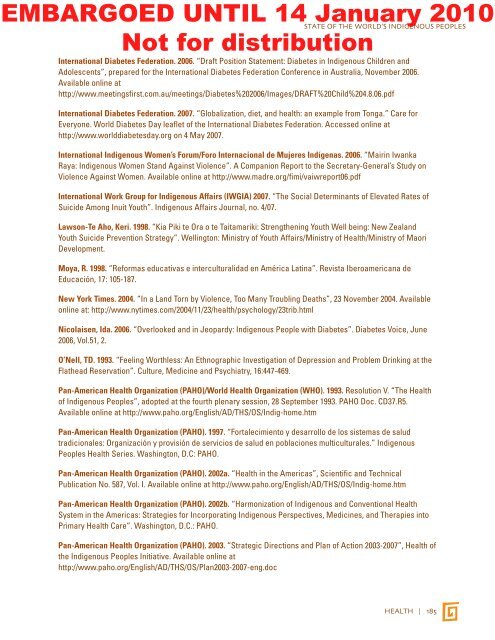STATE OF THE WORLD's INDIGENOUs PEOpLEs - CINU
STATE OF THE WORLD's INDIGENOUs PEOpLEs - CINU
STATE OF THE WORLD's INDIGENOUs PEOpLEs - CINU
- No tags were found...
You also want an ePaper? Increase the reach of your titles
YUMPU automatically turns print PDFs into web optimized ePapers that Google loves.
EMBARGOED UNTIL 14 January 2010<strong>STATE</strong> <strong>OF</strong> <strong>THE</strong> WORLD’S INDIGENOUS PEOPLESNot for distributionInternational Diabetes Federation. 2006. “Draft Position Statement: Diabetes in Indigenous Children andAdolescents”, prepared for the International Diabetes Federation Conference in Australia, November 2006.Available online athttp://www.meetingsfirst.com.au/meetings/Diabetes%202006/Images/DRAFT%20Child%204.8.06.pdfInternational Diabetes Federation. 2007. “Globalization, diet, and health: an example from Tonga.” Care forEveryone. World Diabetes Day leaflet of the International Diabetes Federation. Accessed online athttp://www.worlddiabetesday.org on 4 May 2007.International Indigenous Women’s Forum/Foro Internacional de Mujeres Indígenas. 2006. “Mairin IwankaRaya: Indigenous Women Stand Against Violence”. A Companion Report to the Secretary-General’s Study onViolence Against Women. Available online at http://www.madre.org/fimi/vaiwreport06.pdfInternational Work Group for Indigenous Affairs (IWGIA) 2007. “The Social Determinants of Elevated Rates ofSuicide Among Inuit Youth”. Indigenous Affairs Journal, no. 4/07.Lawson-Te Aho, Keri. 1998. “Kia Piki te Ora o te Taitamariki: Strengthening Youth Well being: New ZealandYouth Suicide Prevention Strategy”. Wellington: Ministry of Youth Affairs/Ministry of Health/Ministry of MaoriDevelopment.Moya, R. 1998. “Reformas educativas e interculturalidad en América Latina”. Revista Iberoamericana deEducación, 17: 105-187.New York Times. 2004. “In a Land Torn by Violence, Too Many Troubling Deaths”, 23 November 2004. Availableonline at: http://www.nytimes.com/2004/11/23/health/psychology/23trib.htmlNicolaisen, Ida. 2006. “Overlooked and in Jeopardy: Indigenous People with Diabetes”. Diabetes Voice, June2006, Vol.51, 2.O’Nell, TD. 1993. “Feeling Worthless: An Ethnographic Investigation of Depression and Problem Drinking at theFlathead Reservation”. Culture, Medicine and Psychiatry, 16:447-469.Pan-American Health Organization (PAHO)/World Health Organization (WHO). 1993. Resolution V. “The Healthof Indigenous Peoples”, adopted at the fourth plenary session, 28 September 1993. PAHO Doc. CD37.R5.Available online at http://www.paho.org/English/AD/THS/OS/Indig-home.htmPan-American Health Organization (PAHO). 1997. “Fortalecimiento y desarrollo de los sistemas de saludtradicionales: Organización y provisión de servicios de salud en poblaciones multiculturales.” IndigenousPeoples Health Series. Washington, D.C: PAHO.Pan-American Health Organization (PAHO). 2002a. “Health in the Americas”, Scientific and TechnicalPublication No. 587, Vol. I. Available online at http://www.paho.org/English/AD/THS/OS/Indig-home.htmPan-American Health Organization (PAHO). 2002b. “Harmonization of Indigenous and Conventional HealthSystem in the Americas: Strategies for Incorporating Indigenous Perspectives, Medicines, and Therapies intoPrimary Health Care”. Washington, D.C.: PAHO.Pan-American Health Organization (PAHO). 2003. “Strategic Directions and Plan of Action 2003-2007”, Health ofthe Indigenous Peoples Initiative. Available online athttp://www.paho.org/English/AD/THS/OS/Plan2003-2007-eng.docHEALTH | 185
















